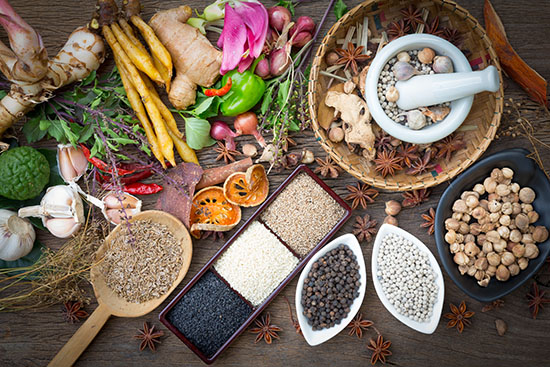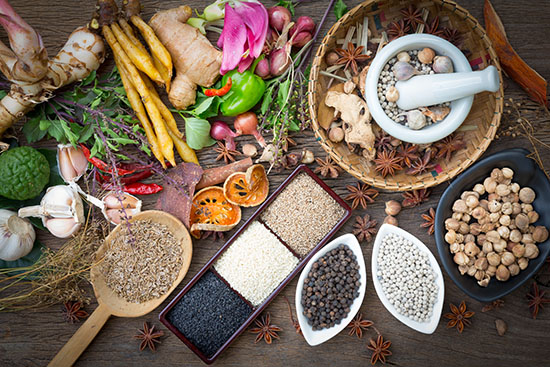
To many people Chinese herbs may feel exotic and mystical and very foreign, for a good reason. In treating serious illnesses and complicated conditions with herbs, you need a practitioner who is well-trained in the properties, actions, and nuances of Chinese herbs; someone who knows how to combine them into effective formulas.
Chinese herbs can be complicated because each herb carries with it specific properties. Herbs have a temperature, which means that some herbs can cool your body down and others can warm you up. They also have one or more actions, which is the effect it has on your body. For example, an herb can drain excess fluid, build up your energy, or help to dry out phlegm. Herbs also affect specific organs; some benefit your Lungs, while others may help your Liver. And herbs, when combined with one another, may have a synergistic effect—they may strengthen, balance, or offset the actions of other herbs. For that reason, and for maximum effectiveness, herbs are almost always combined into formulas.
Despite the complexity of dealing with them, you may be surprised to know that you likely have many Chinese herbs in your kitchen right now. That’s because some of these herbs are also foods and common spices. In fact, Chinese herbs are everywhere. Here are 8 examples and how to use them:
-
- Ginger is a warm and spicy herb that has many uses. It can be effective in treating nausea and vomiting, and can be helpful for people undergoing chemotherapy. Ginger is useful in helping you ward off a cold in the early stages. A little known fact: pickled ginger is almost always served with sushi because it can help protect you from seafood poisoning. To use ginger at home, grate or slice it into soups, stir fried dishes, or boil it in hot water for tea.
-
- Scallions are also warm and spicy. They’re warm enough to help drain congested sinuses and help you sweat out a cold. A simple formula for an early cold is to combine chopped scallions and grated ginger in boiling water or broth. Drink it down and go to bed to sweat out your cold. (This is not the right formula if you’re already sweating or running a high fever; instead use cooling herbs like mint).
-
- Cinnamon is also a warm and spicy herb, but its flavor is sweeter than ginger or scallions. Cinnamon can also be used to drive out a cold, however, its warming effects are better if you feel achy with your cold. Cinnamon can also be used for joint pain that’s worse in the cold weather. It can work as a mild antibiotic for low-grade bacterial infections. Ground cinnamon can be used as a sweet spice in baking or mixed with cooked fruit. It’s also found in whole sticks, which can be used in tea, stews, soups, or curried dishes.
-
- Turmeric has gotten a lot of attention lately, and for good reason. It’s warm and bitter and somewhat moving. Turmeric can be used for inflammation, pain, and to increase the circulation of blood. To use it in cooking, peel and chop fresh turmeric root, or used powdered and dried turmeric in soups, vegetable dishes, and stews.
-
- Mint is a cooling herb that is useful for colds and flu in which you’re running a fever. It can help cool you off and alleviate a sore throat, headaches, and a cough. In Chinese medicine, mint is also used to help drive a rash to the surface of your skin to speed up its healing. Mint is best boiled in hot water, mixed with a little honey, and drunk as a tea. Fresh mint may also be added to curries and stews.
-
- While you may only think of walnuts as an ingredient when you’re baking, it is actually considered to be a useful Chinese herb. Walnuts are warming and help to strengthen your overall metabolism, build up your Kidney system, and help to moisten your intestines to relieve constipation. Try them mixed with raisins for a nutritious snack or baked into your favorite cookies or banana/zucchini/pumpkin bread.
-
- Watermelon doesn’t look anything like what you think a Chinese herb might be. However, as an herb watermelon is very cooling, moist, and sweet. It’s used in treating fevers, loss of appetite, fatigue, and inflammation that arise from the hot weather. No preparation is needed; you can just slice it and eat.
- White rice is considered to be slightly cool, sweet, and nourishing. It’s used to treat digestive problems, diarrhea, and is a good choice for a sensitive stomach after you’ve had the flu or food poisoning. You can just steam the rice and eat, or mix it one part rice to seven parts water and slow cook it to make a thick, porridge-like soup. Add miso broth and ginger to settle a queasy stomach or cinnamon and dates for breakfast.
In a Chinese herbal pharmacy, most of these herbs are dried. They’re mixed into various formulas, either whole or powdered. Combining Chinese herbs into formulas can be complicated and should be left to a licensed practitioner of Chinese medicine. There’s good news though in that many of these same herbs can be eaten as foods, and are as accessible as your nearest grocery store.

Cindy Chamberlain is an acupuncturist in Overland Park, KS and the founder of Eastern Healing Solutions, LLC. She is licensed in Kansas and Missouri and has been practicing traditional Chinese medicine since 1996.


